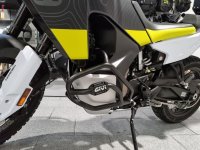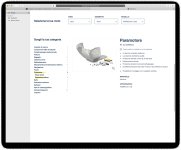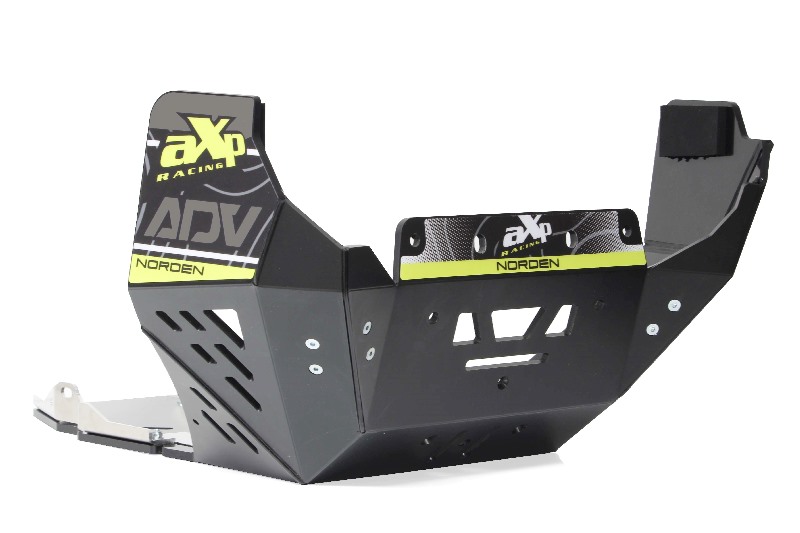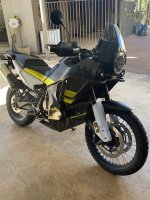I don't know about you, but I'm always struggling with the indecision between the crash bars and the Apx racing skidplate. When I decided to take the norden, the main reason was to be able to have a lighter and more compact bike than the V2 ktm's that I have had in the last six years, and this in a way contrasts with the crashbars, and certainly the lightness is a point in favor of asp.
But, in reality, how do the two systems work? The crashbars are a rigid system that uses three fixing points on each side, one on the engine and two, I understand, on the frame. The bars on the V2 ktm had two points on the frame and one on the engine for each side, and were then connected to the base of the radiator. Certainly some points of the engine and frame are designed to be able to withstand these stresses, with greater thicknesses of material or localized heat treatments. In the case of the norden, of the two points on the frame, the first is the fixing of the tank - which, let's remember, is crash proof and would not need any particular protection if not for the aesthetics - the second instead is in the front part, a steel bar in turn fixed to the frame. The third point, on the other hand, seems to me to be a frame flange on the right and the crankcase on the left. A rigid system, in fact, which unloads the forces on pre-established points and "supports" the bike better than the aluminum casing which dissipates the force on the tank through a honeycomb placed between the casing and the tank.
Apx: a sort of 8 mm thick HDPE tank, fixed in 4 points: the two front ones are the same as the crashbar, but in this case the polymer works directly on the steel pin used for fixing. In the rear part, however, we find two aluminum brackets that are fixed, here too, in the same points as the crashbars: in one point on a metal flange of the frame and on another point that seems to me to be of the engine, and on the left, as for the bars, on the lower part of the base. In this case the operation would seem similar to that of the original crankcase / honeycomb, however the tank transmits the effort directly to the tank, albeit through a fairly large surface (if it rests on a more or less regular surface). A sort of elastic system, which however makes the tank work.
Honestly, it seems to me that, all in all, the bars have a more consistent functioning: they transfer the effort to three points and completely bypass the surface of the tank, while the response of the axp tank seems to me to depend more on the surface where it falls.
Finally, strengths and weaknesses (in my opinion, of course):
Crashbar:
ADVANTAGES: price, resistance, greater protection for the upper part of the hull, less stress on the handlebar due to the fall.
DEFECTS: heavy weight, aesthetically invasive, problems in case of "joint" with protrusions.
Apx skidplate
ADVANTAGES: low weight, not excessively invasive from an aesthetic point of view, probably less "resistance" to any protruding obstacles.
DEFECTS: apparent poor resistance of the rear supports and of molded corners, plastic material that works in direct contact with the steel for front fixing points, direct contact with the tank in case of a fall, high price, unknown (for me) payment system.
In short, I would tend for the bars, but I am still hesitant ...
But, in reality, how do the two systems work? The crashbars are a rigid system that uses three fixing points on each side, one on the engine and two, I understand, on the frame. The bars on the V2 ktm had two points on the frame and one on the engine for each side, and were then connected to the base of the radiator. Certainly some points of the engine and frame are designed to be able to withstand these stresses, with greater thicknesses of material or localized heat treatments. In the case of the norden, of the two points on the frame, the first is the fixing of the tank - which, let's remember, is crash proof and would not need any particular protection if not for the aesthetics - the second instead is in the front part, a steel bar in turn fixed to the frame. The third point, on the other hand, seems to me to be a frame flange on the right and the crankcase on the left. A rigid system, in fact, which unloads the forces on pre-established points and "supports" the bike better than the aluminum casing which dissipates the force on the tank through a honeycomb placed between the casing and the tank.
Apx: a sort of 8 mm thick HDPE tank, fixed in 4 points: the two front ones are the same as the crashbar, but in this case the polymer works directly on the steel pin used for fixing. In the rear part, however, we find two aluminum brackets that are fixed, here too, in the same points as the crashbars: in one point on a metal flange of the frame and on another point that seems to me to be of the engine, and on the left, as for the bars, on the lower part of the base. In this case the operation would seem similar to that of the original crankcase / honeycomb, however the tank transmits the effort directly to the tank, albeit through a fairly large surface (if it rests on a more or less regular surface). A sort of elastic system, which however makes the tank work.
Honestly, it seems to me that, all in all, the bars have a more consistent functioning: they transfer the effort to three points and completely bypass the surface of the tank, while the response of the axp tank seems to me to depend more on the surface where it falls.
Finally, strengths and weaknesses (in my opinion, of course):
Crashbar:
ADVANTAGES: price, resistance, greater protection for the upper part of the hull, less stress on the handlebar due to the fall.
DEFECTS: heavy weight, aesthetically invasive, problems in case of "joint" with protrusions.
Apx skidplate
ADVANTAGES: low weight, not excessively invasive from an aesthetic point of view, probably less "resistance" to any protruding obstacles.
DEFECTS: apparent poor resistance of the rear supports and of molded corners, plastic material that works in direct contact with the steel for front fixing points, direct contact with the tank in case of a fall, high price, unknown (for me) payment system.
In short, I would tend for the bars, but I am still hesitant ...
Last edited:




